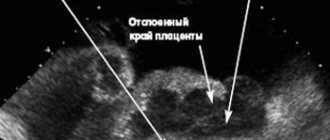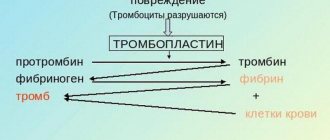The placenta, or as it is also called, “baby place” and afterbirth, is a special organ that develops in a woman’s body during pregnancy. The duration of functioning of the placenta is 40 weeks, that is, the gestational age. After the birth of a child, the “baby place” becomes unnecessary, since all its functions are completed and therefore it is removed from the mother’s uterus.
However, like any organ, the placenta, during the short period of gestation, goes through all stages of development - from conception to death. Immediately after birth, the placenta itself separates from the walls of the uterus and thus ends its functioning. But all stages of life - birth, development, formation, aging and death - the placenta manages to go through in 9 months.
Although the afterbirth is considered a short-lived organ, it is extremely important for the proper growth of the fetus in the womb. Throughout pregnancy, it is necessary to monitor its condition, since it is the placenta that is responsible for the life support of the baby. The functioning of the “baby place” is monitored using ultrasound.
Premature maturation of the placenta during pregnancy
The placenta is an organ that a woman needs only during pregnancy.
The placenta is formed on the 12th day of pregnancy, and ceases to exist with the birth of the child. The formation of the placenta occurs on the wall of the uterus, at the time and place where the fertilized egg is attached. For the first three months it does not function. During this time, it gains weight (usually 500 g), increases in size (up to 20 cm) and fuses with the uterus through the circulatory system. The umbilical cord connects the placenta to the fetus.
After three months, at about 12 weeks, the placenta begins to fully function.
The main functions of the placenta include:
- delivery of nutrients and oxygen to the fetus;
- removal of metabolic products from the fetal body;
- barrier to toxins, viruses and bacteria.
Stages of placenta development
There are 4 degrees of placental maturation:
- the formation stage is the zero stage, lasting up to 7.5 months (30 weeks);
- growth stage - the first stage, lasts from 6 to 9 months (27-36 weeks);
- maturity stage - the second stage, lasts at 8-9 months (34-39 weeks);
- aging stage – begins in the middle of the 8th month (from 36-37 weeks).
Before the formation of the placenta (the first 12 days), the unborn child is not yet connected to the mother’s body by the circulatory system, so any toxic substances cannot affect it. But at the stage of placenta formation, the fetus becomes very vulnerable. In the first three months, taking alcohol and medications can cause significant harm to the fetus.
The placenta begins to perform its functions and undergo changes after 3 months of pregnancy. For full development, the fetus must receive the necessary nutrients, which is achieved through the growth of the placenta and its blood vessels.
At 36 weeks, the placenta reaches the stage of full maturity. From this moment on, its gradual aging occurs. Aging is accompanied by drying out of blood vessels, deposition of salts, etc. This can negatively affect the baby during post-term pregnancy.
Ways to determine the degree of placenta development
The level of development of the placenta and its relationship with the gestational age is determined during an ultrasound examination. The following indicators are studied:
- echostructure - the density of placental tissue (changes during pregnancy);
- thickness;
- the presence of accumulations of salts (petrificates).
At the zero stage of development, the placenta has a homogeneous structure. By the stage of the 1st degree of development (approximately the 27th week of pregnancy), the structure may begin to change towards slight waviness, and echogenic inclusions may appear.
By the 3rd stage of development, the placenta already has a structure divided into lobes and areas where salt deposits have appeared. However, a situation may arise that the placenta is ahead of its development period.
This situation is called early or premature maturation of the placenta.
Causes of premature ripening of the placenta
There are several conditions that contribute to the early maturation of the placenta, and they all depend on the health of the expectant mother:
- underweight woman;
- overweight;
- late toxicosis;
- bleeding disorders;
- viral infections;
- chronic diseases;
- complicated pregnancy.
Thus, when conditions arise for increased work of the placenta, its accelerated development occurs. For example, to protect the unborn child from polluted air or the consequences of poor nutrition of the mother. Various diseases of a woman also activate the defense mechanism.
All these factors lead to accelerated deterioration of the placenta, and subsequently, to its aging ahead of schedule.
What are the dangers of early maturation of the placenta?
Early maturation of the placenta does not pose a great danger to the fetus, but requires additional attention and ultrasound throughout pregnancy. Because if the placenta ages prematurely, the blood supply to the fetus may be disrupted (fetoplacental insufficiency), and the fetus in this case will not receive the required amount of nutrients and oxygen.
In rare cases, early maturity of the placenta can lead to premature birth and chronic fetal hypoxia.
If the 3rd degree of placenta development occurs before the 9th month of pregnancy (about 37 weeks), we can talk about its premature aging.
A slight advance in the development of the placenta, as a rule, does not pose a threat to the unborn child. According to statistics, this is a rare (most often inherited) feature of a particular woman.
Both the baby and the placenta can exist normally under these conditions.
The loss of some functions of the placenta (placental insufficiency) can only be discussed when any abnormalities are detected in the fetus.
To prevent fetoplacental insufficiency, cardiotocography (CTG during pregnancy) should be done to examine the uteroplacental blood flow. If no disturbances are observed, then the placenta may not be affected.
If fetoplacental insufficiency is detected, ensuring normal blood supply to the fetus can be restored with the help of medications.
But if treatment is not carried out, this can negatively affect the child’s health.
Premature maturation of the placenta, and then aging, manifests itself in a change in its thickness. It depends on the pathology of pregnancy.
A placenta of less than 20 mm in the period from the 7th month of pregnancy can be called thinner than normal. This is facilitated by late toxicosis, delayed fetal development, and the threat of miscarriage.
The placenta becomes thicker than normal (more than 50 mm) in diabetes mellitus and hemolytic disease.
Thinning or thickening of the placenta requires treatment and a repeat ultrasound.
If early aging of the placenta is detected, there is no need to panic. This does not categorically affect the condition and date of birth of the unborn child, but only requires additional attention and treatment procedures.
Source: https://www.rastut-goda.ru/pregnancy-and-childbirth/7972-prezhdevremennoe-sozrevanie-placenty-pri-beremennosti.html
Placenta and its functions
The main task of such an organ is to provide the future baby with all the necessary nutrients, vitamins and minerals. It performs this function throughout the entire period of pregnancy. The child seat also , such as:
- removal of toxins;
- protection from negative influences of the external environment, as well as bacteria and viruses;
- delivers oxygen to the child in the required volume and removes carbon dioxide;
- supplies the baby with necessary nutrients and eliminates waste products;
- provides protection for the fetus in terms of immunology, that is, the necessary antibodies of the woman to the child are passed through the placenta, but immediately retains cells of the mother’s immune system that could harm the child and trigger the mechanism of embryo rejection if they were mistaken for a foreign object.
The condition of the child's place itself has a rather important impact on the child's condition. And also for the entire period of pregnancy. It is necessary to provide this body with support and protect it from negative impacts of various kinds. For example, you should visit crowded places less often, especially during epidemics, because even simple viral diseases of acute respiratory infections or acute respiratory viral infections can pose dangers. You should also stop smoking. And if genital tract infections are detected, they must be treated.
How does the placenta mature during pregnancy?
The maturation of the placenta during pregnancy largely determines the degree of fetal development. The placenta itself is a unique organ that creates an isolated place for the long-term presence and growth of the embryo. In order to monitor pregnancy, the maturation of the placenta must be constantly monitored.
Various abnormalities in this temporary organ can cause serious problems. When the degree of placenta maturity is determined by week, the table makes it possible to compare real results with the norm and take timely measures if there are deviations.
What does the organ consist of?
The placenta is a temporary embryonic organ that begins to form immediately after implantation of a fertilized egg and is rejected after childbirth . It matures, as a rule, on the posterior uterine wall, but can also develop normally on the anterior wall. Such an organ is formed on the mucous membrane from the endometrium and cytotrophoblast.
The placenta, as it develops, increases in size, consisting of the following layers: decidual tissue, formed by transformation of the endometrium; fibrinoid layer of Langhans; trophoblast, covering the lacunae and fused to the arterial walls; lacunae with blood mass; syncytiotrophoblast; cytotrophoblast; stroma in the form of connective tissue with vessels; amnion for the synthesis and adsorption of amniotic fluid. The connection between the embryo and the placenta is carried out by the umbilical cord.
In terms of their structure, there are differences between the fetal and maternal surfaces of the placenta. The surface adjacent to the embryo is formed by amnions and has the appearance of a smooth gray shell.
In the middle part, the umbilical cord approaches, from the junction with which numerous vessels run in different directions.
The surface facing the maternal organ has a dark brown tint and is divided into 18-21 lobules (cotyledons).
Structure of the placenta
The fetal blood penetrates the capillaries from the umbilical cord arteries, and oxygen from the maternal blood spreads through the capillaries of the embryo, and carbon dioxide from its blood returns to the maternal blood. To prevent direct mixing of maternal and fetal blood there is a placental barrier.
What functions does the placenta perform?
The placenta performs a number of important functions, without which the preservation and development of the fetus is impossible. The following main functions are distinguished:
- gas exchange (respiratory function): supply of oxygen and removal of carbon dioxide;
- nutrition and removal of harmful substances: supply through the placenta of water, vitamins, electrolytes, essential microelements and removal (transportation) of metabolic products;
- protection: transporting maternal antibodies to the embryo that provide immune protection; the placenta regulates the development of the immune system and prevents immune contradictions between maternal cells and embryonic cells as foreign elements;
- hormonal role: the placenta performs the functions of the endocrine system, producing gonadotropin, prolactin, progesterone, estrogens and some other hormones.
Principles of placenta development
The mechanism of placenta formation is a complex physiological process. After fertilization, a cavity (lacuna) appears in the uterine wall, filled with the mother’s blood. The embryo is fixed in this cavity, which receives the necessary nutrition directly from the tissues of the female body.
Cytotrophoblasts located around the embryo, through rapid division, create a branched membrane with a network of lacunae. The vascular system of the embryo grows into the branches of this membrane, which provides a connection between the blood system of the mother and the embryo. In this case, there is no direct exchange of blood, and communication is ensured in a diffuse manner.
As a result of the primary process, the placenta is born, which is an organ that belongs to both the woman and the child.
Formed placenta
Already 3 weeks after conception, the placenta begins to perform its respiratory function, but until 12-13 weeks its structure is not considered fully formed and does not have clear boundaries.
Until 6-7 weeks, this formation is called chorion, and only then does real placentation begin. An important indicator of development is the degree of maturity of the placenta.
In the second trimester of pregnancy, it is the maturity of the placenta that already makes it possible to assess physiological and pathological processes. In general, the maturity of the placenta is divided into 4 degrees by week.
Stages of organ maturation
The degree of maturity of the placenta is 0, i.e. The initial stage of organ formation normally occurs within 30 weeks after conception.
During this period, the placenta has a fairly homogeneous structure and develops from a fuzzy amorphous system to the first signs of maturation.
The main functional development is observed starting from 11-12 weeks, when the growth of the placenta and thickening of the membrane are actually observed. One of the main indicators of the zero stage is surface smoothness.
Degree of placental maturity 1 begins with the manifestation of signs of maturation on the placenta, expressed in a violation of the smoothness of the surface - slight waviness, inclusions. Ultrasound reveals individual zones of echogenicity. The normal course of pregnancy involves the development of this stage in the period 27-34 weeks.
The degree of maturity of the placenta 2 is characterized by the appearance of a noticeable relief on the surface of the organ, obvious convolutions of the membrane are recorded, ultrasound shows the presence of numerous changes in echogenicity. The average duration of this period is 34-39 weeks.
The placenta of the 3rd degree of maturity is a finally matured organ that has performed all the necessary functions and is preparing for childbirth. The transition stage to this degree normally begins at 38 weeks of pregnancy.
The main external characteristic is the appearance of a pronounced lobular structure and significant tortuosity of the membrane. This period expresses the natural aging of the placenta.
This degree of maturity indicates that the fetus is actually mature, and therefore childbirth after 37 weeks of pregnancy is considered completely acceptable.
Premature onset of stage 3 placenta maturity is very dangerous and is fraught with premature birth and insufficient development of the child.
An important characteristic of the maturation of the placenta is its thickness. It is this parameter that is often used to monitor placental development. The table shows the norms for this parameter by week of pregnancy.
Table. Norms for placental thickness during pregnancy by week
What anomalies occur during development
As the placenta matures, some abnormalities may be detected that may affect the health of the pregnant woman, the development of the child, or the course of future births. Such disturbances may be revealed in the location of the placenta, its size or timing of maturation.
A fairly important indicator is the location of the placenta attachment site in the uterine cavity.
So, for many women, in the early weeks of pregnancy this place is located almost at the uterine outlet, but as the size of the uterus increases, the placenta rises higher.
However, some women may experience excessively low attachment of the placenta even in the 3rd trimester, which is dangerous due to its premature detachment.
The presence of the so-called placenta previa, when it is located near the internal os, and sometimes overlaps it, causes great concern. This phenomenon can be caused by previous abnormal births, abortions, tumor formations, and abnormal uterine structure. The danger of the anomaly is the risk of bleeding and premature birth. The situation requires constant monitoring using ultrasound.
Quite rarely, but still there are cases of placental villi growing into the muscular structure of the uterus or uterine walls (placenta accreta).
Such placental remnants are not removed from the uterus with menstruation and can cause serious bleeding in the postpartum period. Treatment in such cases involves surgical intervention.
Similar problems are caused by excessively tight attachment of the placenta to the uterine wall.
One of the most serious pathologies is placental abruption . The anomalies discussed above may contribute to such a pathology. It can occur in early labor or at any stage of pregnancy. When pathology appears, the woman needs urgent hospitalization, and the measures taken depend on blood loss and the area of detachment.
One of the most serious pathologies is placental abruption
Violation of the maturation of the placenta
Abnormal development of the placenta is often expressed in violation of the timing of maturation. Any anomalies in one direction or another in this direction are dangerous for the development of the fetus, since the nutrition of the embryo is disrupted.
Excessively early maturation of the placenta can be caused by various pathogenic causes: infections, hormonal imbalance (especially with diabetes), gestosis, multiple pregnancy, endocrine pathologies, hereditary predisposition.
Factors such as smoking, drinking alcohol, and poor nutrition can have a serious impact, especially with a deficiency of vitamins and essential microelements.
Premature maturation and aging of the placenta can significantly affect the development of the fetus in terms of providing nutrients and oxygen. If such a sign is detected, it is necessary to provide complex therapy. For these purposes, drugs such as Actovegin, Curantil, Essentiale are prescribed.
Delayed organ maturation can also significantly affect the course of pregnancy. This pathology is considered quite rare, and, as a rule, is caused by congenital defects. Smoking and diabetes mellitus in women significantly increase the risk of pathology.
The placenta plays a crucial role in the formation and development of the fetus. Its maturation is subject to certain physiological laws, but there may also be failures due to a number of factors.
Source: https://AntiRodinka.ru/kak-proischodit-sozrevanie-platsenti-vo-vremya-beremennosti
Degrees of placenta maturity
The placenta, or as it is also called, “baby place” and afterbirth, is a special organ that develops in a woman’s body during pregnancy. The duration of functioning of the placenta is 40 weeks, that is, the gestational age. After the birth of a child, the “baby place” becomes unnecessary, since all its functions are completed and therefore it is removed from the mother’s uterus.
However, like any organ, the placenta, during the short period of gestation, goes through all stages of development - from conception to death. Immediately after birth, the placenta itself separates from the walls of the uterus and thus ends its functioning. But all stages of life - birth, development, formation, aging and death - the placenta manages to go through in 9 months.
Although the afterbirth is considered a short-lived organ, it is extremely important for the proper growth of the fetus in the womb. Throughout pregnancy, it is necessary to monitor its condition, since it is the placenta that is responsible for the life support of the baby. The functioning of the “baby place” is monitored using ultrasound.
Development and main functions of the placenta
The development of the placenta begins at the moment of fertilization of the egg. The embryo, in which active division and development occurs at this stage, contains a rudiment of cells called trophoblast cells, which are necessary for connecting the fetus with the tissues of the mother.
The enzymatic activity of this group of cells is so high that the embryo easily penetrates the mucous membrane of the uterus and begins to receive nutrition directly from the maternal tissues.
At this moment, the trophoblast cells continue their active division, as a result of which a membrane is formed around the embryo, which is the placenta.
Usually, by the end of the first trimester, the structure of the placenta is fully formed. However, during pregnancy its structure may change depending on the needs and age of the fetus.
This ability is called the degree of maturity of the placenta. During the period 22-36 weeks of gestation, the placenta actively gains mass and after this full functional maturity occurs.
By the end of pregnancy, the thickness of a well-developed placenta ranges from 2 to 4 cm, and the diameter is 16-18 cm.
As mentioned above, the placenta is responsible for the life support of the fetus until the moment of birth. There are five main functions of the placenta: gas exchange, nutritional, excretory, protective and hormonal functions.
Each is responsible for the proper development of all organs and the condition of the child as a whole.
Thus, the first facilitates the production of oxygen, the second is responsible for the intake of nutrients, the third is responsible for the removal of waste products of the child, the fourth performs the function of the immune system, and the fifth produces hormones that are vital during the development of the baby.
What does the degree of maturity of the placenta mean?
The placenta, like any other organ, has its own degree of maturity, which reflects a certain stage in formation and physiological changes. Simply put, the degree of maturity is the stage of aging of the placenta.
Each degree of maturity is characterized by specific features of the structure and thickness of the placenta.
Only 4 degrees of placental maturity have been defined, they are designated by numbers from 0 to 3, so the 0th degree is considered the youngest, and the 3rd is the oldest.
The aging process of the “baby place” occurs gradually and corresponds to the specific age of the fetus. Today, there are certain norms for the relationship between the degree of maturity of the placenta and the gestational period. Normally it looks like this:
- Grade 0 corresponds to a gestation period of up to 30 weeks;
- 1st degree – 30-34 weeks;
- 2nd degree – from 35 to 39 weeks inclusive;
- Stage 3 – can begin from the 37th week until the moment of birth.
If the pregnancy proceeds normally, then usually the degree of maturity of the placenta corresponds to the norms, and then the fetus fully receives all the necessary substances.
In the case when there is a discrepancy between the gestational age and the maturity of the placenta, this indicates a possible deviation from the normal functioning of the placenta, as a result of which the baby may suffer, since he does not receive everything necessary for his full growth.
What are the dangers of premature aging of the placenta?
Sometimes it happens that the degree of maturity of the placenta is greater than it should be at a certain stage of pregnancy. For example, the gestation period is 26 weeks, and the degree of maturity is already at level 1 or 2, which is a deviation from the norm.
Doctors call this pathology premature aging of the organ, which indicates the development of fetoplacental insufficiency, which is extremely dangerous for the baby, as hormonal and immune disruptions, nutritional and oxygen deficiency, etc. develop.
Also, placental insufficiency can provoke underdevelopment of the child’s organs, fetal death, premature birth and other serious complications of pregnancy.
We recommend reading:
- Consequences of hypoxia in a newborn
- Gestational diabetes in pregnant women
The development of premature aging of the placenta depends on two factors - individual characteristics and any pathological processes occurring in the body of a pregnant woman.
For example, the cause of rapid aging of the placenta may be a previous abortion, endocrine pathology, multiple pregnancy, intrauterine infection, smoking, taking alcohol or drugs, etc.
Be that as it may, it is important to remember that premature aging of the placenta is very dangerous and requires treatment in a hospital setting.
Source: https://lady-stories.ru/beremennost-i-rody/stepeni-zrelosti-placenty
Placenta maturity by week
- We need you! Click for details!
The placenta is a truly unique organ, because it appears only when a new life is born and dies simultaneously with the birth of a person, existing for about 40 weeks.
The importance of the role of the placenta is difficult to overestimate: first of all, it carries out gas exchange in the circulatory systems of the mother and child, transporting oxygen to the fetus. The child also receives all nutrients through it.
The placenta also provides protection to the baby, becoming a kind of barrier to viruses and bacteria. Also, throughout its existence, it performs other functions that will later become independent for the baby - the role of the endocrine system, excretory system and others.
What is placenta maturity by week - an expression that the expectant mother will hear starting from the second trimester?
Since this organ is temporary, it develops and matures, and shortly before birth it begins to age. This process of physiological aging is expressed in the fact that the placenta becomes denser, its surface area decreases, and areas of salt deposition appear.
Degree of placenta maturity 0-1
Zero degree means that the placenta is still growing, it is young and does all its work normally. The degree of placental maturity 0 should ideally be up to the 30th week of pregnancy. But, of course, this does not always happen, and in some cases, already from the 27th week, an ultrasound examination reveals the first degree.
Why is this happening? At these stages of pregnancy, premature ripening of the placenta can be caused by a disease the woman has suffered, as well as by the presence of bad habits - drinking alcohol and nicotine during pregnancy.
In itself, the presence of the first degree of maturity does not have any special consequences for the baby, however, the best option would be that degree 1 will be diagnosed at a later date - for example, placenta maturity at 32 weeks .
The norm is the presence of grade 1 in a period of 30 to 34 weeks.
It should be understood that doctors conduct comprehensive studies, and the condition of the placenta is assessed not only by its degree. So, it is very important to know the location of the placenta.
In some cases, it covers the internal os of the cervix. When assessing placental maturity at 32 weeks, it will be important for doctors to know whether the placenta has shifted.
If not, then this phenomenon is called placenta previa and will be a serious complication.
Degree of placenta maturity 2-3
As we said, things don't always go according to plan.
Therefore, when a woman is looking for an answer to the question of what the degree of maturity of the placenta should be at 33 weeks, the ideal answer - the first degree - does not mean at all that this happens for everyone.
Very often, the signs of placental aging at this stage are more pronounced, so in the results of the study you can find, for example, the value “1-2 placental maturity.”
It is not the dry numbers that are important, but the condition of the fetus, so doctors carefully check how your baby is feeling, whether he is developing normally, and whether his size corresponds to the gestational age.
Usually, in addition to ultrasound examination, CTG (cardiotocography) and Doppler testing are also prescribed to assess the condition of the fetus. Therefore, when receiving results “1-2 maturity of the placenta,” there is no point in worrying.
They will definitely tell you how your pregnancy is going.
So, degrees of placenta maturity 2-3 already indicate that the placenta is fully mature (second degree), and its natural aging has begun (third degree). In a normal pregnancy, grade 2 should correspond to 35-39 weeks, and grade 3 should appear at 40 weeks. In fact, the third degree of maturity is often determined already from the 37th week.
Aging of the placenta: stages
Maturation and aging of the placenta is a natural process. We can talk about the pathology of this process if the placenta begins to age ahead of schedule. Aging of this organ leads to a decrease in its functions. The placenta of the second degree of maturity stops growing and cannot fully provide oxygen and nutrients to the child during its development. Signs of premature aging are diagnosed by ultrasound and CTG.
The development of the placenta goes through four stages:
- The placenta is formed from 2 to 30 weeks,
- From 30 to 33 weeks growth occurs,
- From 34 to 36 weeks the placenta matures,
- At 37 weeks the placenta ages.
In some cases of placenta aging too quickly, doctors may advise terminating the pregnancy.










